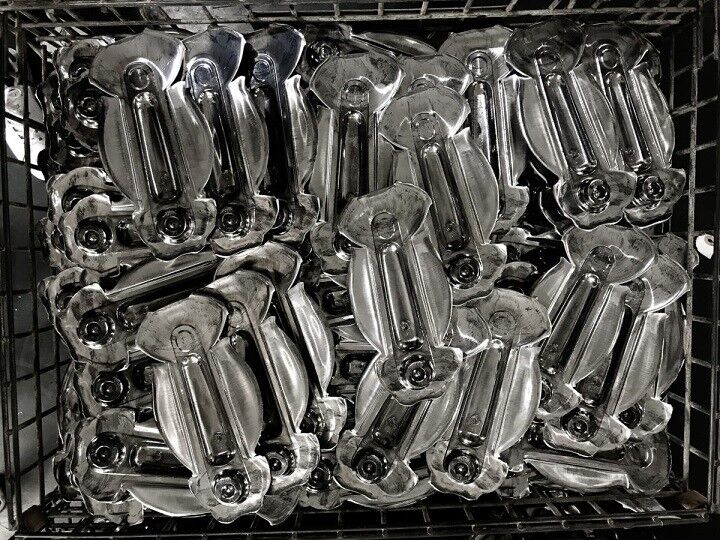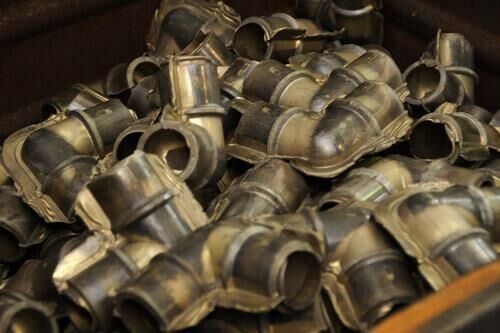Forged Aluminum vs Forged Brass
When designing a drop forged part, aluminum and brass are the common forging materials to consider. The same point between forged aluminun and forged brass is that they are all made from drop forging, which can creat metal parts with great strength, close tolerance and good surface finish. Meanwhile there exsits differences between these two types of forging materials. Before making a decision, it is important to understand the differences between forged aluminum and forged brass.
 Compared to other forged metals, forged aluminum is famous for its light weight, while maintaining good strength. Common forged aluminum alloys include 6061, 6063, 6082, 7075, etc. Of course, aluminum alloy can also be used as cast material, such as A356, A380, etc. Never mix cast aluminum with forged aluminum, they are different manufacturing process and different aluminum grades.
Compared to other forged metals, forged aluminum is famous for its light weight, while maintaining good strength. Common forged aluminum alloys include 6061, 6063, 6082, 7075, etc. Of course, aluminum alloy can also be used as cast material, such as A356, A380, etc. Never mix cast aluminum with forged aluminum, they are different manufacturing process and different aluminum grades.
Besides light weight, forged aluminum is also relatively soft compared with forged steel or forged brass. If aluminum forgings will be further machined, then it have to be heat treated in T6 condition. As heat treatment can effectively imporve the hardness of the forging parts.
 Brass is an alloy of copper and zinc, so named because of its yellow color. It has good mechanical and wear resistance, and can be used to make forged brass parts for valves fittings, pipe fittings, air conditioning fittings, etc. Forging brass is a brass shaping technique that uses heated brass bars. Since forging is a hot metal forming method, the brass alloys that work well for this are chosen for their good to excellent hot deformability performance.
Brass is an alloy of copper and zinc, so named because of its yellow color. It has good mechanical and wear resistance, and can be used to make forged brass parts for valves fittings, pipe fittings, air conditioning fittings, etc. Forging brass is a brass shaping technique that uses heated brass bars. Since forging is a hot metal forming method, the brass alloys that work well for this are chosen for their good to excellent hot deformability performance.
Brass forging process begins with cutting brass bar stock into pre-cut cylindrical blanks or billets large enough for the forged parts being made. These billets are then heated to the point where the brass becomes somewhat pliable. Each billet is then pressed in between dies or forms at very high pressure and squeezed into the basic shape of the part. After forging, any flash is trimmed away from the forged part. It is then shot blasted or further machined to achieve finished parts.
Although the forging process of aluminum and brass alloys are almost the same, there still exsits great differences between forged aluminum and forged brass. As the professional drop forging company, we can produce both forged aluminum parts and forged brass parts. Below the main differences are listed:
Color
Forging will not have great effect on the color of material. So, forged aluminum maintains silver color, while forged brass appears golden yellow color. People can separate forged aluminum from forged brass from the color directly.
Heating Temperature
Both the heating temperatures of forged aluminum and forged brass are lower than that of forged steel , but still exsits difference. The heating temperature of aluminum forging is around 300℃ - 480℃, while the heating temperature of brass forging is around 815℃。
Cost
In terms of cost, forged brass is more expensive for its higher material cost. While forged aluminum is more affordable.
Application
Forged aluminum is mainly used to creat parts when light weight is considered, such as automotive, motorcycle, etc. While forged brass is more widely used to make fittings and other components for valves, pipe connecting, air conditioning, fire fighting, etc.
If you have RFQ's for forged aluminum or forged brass parts, please contact our drop forging factory and send us drawings or samples of your products. We will offer our best prices and qualified products to you.
Forged Aluminum

Besides light weight, forged aluminum is also relatively soft compared with forged steel or forged brass. If aluminum forgings will be further machined, then it have to be heat treated in T6 condition. As heat treatment can effectively imporve the hardness of the forging parts.
Forged Brass

Brass forging process begins with cutting brass bar stock into pre-cut cylindrical blanks or billets large enough for the forged parts being made. These billets are then heated to the point where the brass becomes somewhat pliable. Each billet is then pressed in between dies or forms at very high pressure and squeezed into the basic shape of the part. After forging, any flash is trimmed away from the forged part. It is then shot blasted or further machined to achieve finished parts.
Differences Between Forged Aluminum and Forged Brass
Although the forging process of aluminum and brass alloys are almost the same, there still exsits great differences between forged aluminum and forged brass. As the professional drop forging company, we can produce both forged aluminum parts and forged brass parts. Below the main differences are listed:
Color
Forging will not have great effect on the color of material. So, forged aluminum maintains silver color, while forged brass appears golden yellow color. People can separate forged aluminum from forged brass from the color directly.
Heating Temperature
Both the heating temperatures of forged aluminum and forged brass are lower than that of forged steel , but still exsits difference. The heating temperature of aluminum forging is around 300℃ - 480℃, while the heating temperature of brass forging is around 815℃。
Cost
In terms of cost, forged brass is more expensive for its higher material cost. While forged aluminum is more affordable.
Application
Forged aluminum is mainly used to creat parts when light weight is considered, such as automotive, motorcycle, etc. While forged brass is more widely used to make fittings and other components for valves, pipe connecting, air conditioning, fire fighting, etc.
If you have RFQ's for forged aluminum or forged brass parts, please contact our drop forging factory and send us drawings or samples of your products. We will offer our best prices and qualified products to you.


 sales@dropforging.net
sales@dropforging.net